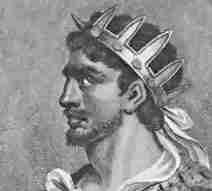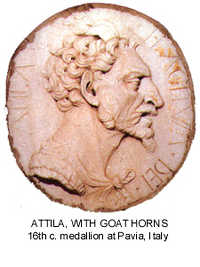|
In the previous forty years the once great Empire had suffered staggering setbacks, especially in the West. Aetius had done more than anyone else to keep what remained of the Roman world strong and prosperous. By 451 Aetius had been the foremost general in the Roman Empire for many years, and he was also the chief political adviser to the Emperor of the West, Valentinian III. Gaul and the Battle of Châlons Attila the Hun's Invasion of Gaul 451 AD When Attila the Hun crossed the Rhine with the Huns in 451, he threatened a tottering relic of power. The Western Roman Empire had already been ravaged by Visigoths, Vandals, Suebi, Alamanni, Burgundians and other Barbarian tribes. Visigoths had an independent kingdom in Aquitaine, and Vandals occupied North Africa with a capital at Carthage. Roman rule in many parts of Gaul and Spain was merely nominal. Although Aetius had waged his own personal fight against the tide of the times, he had not been able to hold back the wave of invasions that had rolled over the West ever since Alaric and the Visigoths had sacked the city of Rome in 410.
Another of the great barbaric chieftains of the age, Gaiseric, King of the Vandals, played a role in the prelude to Châlons. He urged Attila to attack the Visigoths in the West because of the hostility between Vandals and Visigoths. A generation earlier Gaiseric's son had married the daughter of Theodoric I, King of the Visigoths, but in 442 the Roman Emperor Valentinian III agreed to the betrothal of his daughter to Gaiseric's son, and the Visigothic princess was returned to her people with her nose and ears inhumanly mutilated. From that time on the enmity of Vandals and Visigoths was great, and when Attila did cross the Rhine, the Visigoths joined Aetius against the Huns, but the Vandals stayed out of the war. Attila had not expected such vigorous action on the part of the Romans, and he was too wise to let his army be trapped around the walls of Orleans, so he abandoned the siege, according to one source, on June 14. This gave the Romans and their allies the advantage in morale as the Huns withdrew into the open country of the modern Champagne district of France. With great numbers of Ostrogoths, or East Goths, whom he had conquered, in his army, Attila invaded Gaul (451) in alliance with Gaiseric, king of the Vandals. He was met by the Roman general Flavius Aetius and defeated that same year in the great Battle of Châlons, fought on the Catalaunian Plains (some believe closer to Troyes than to Châlons) a great battle was fought, probably about June 20.
The clash at Châlons was one of those rare monumental conflicts, pitting against one another two of the towering figures of Late Antiquity, the fierce and passionate Attila and the noble Aetius, sometimes called "the last of the Romans." On the right wing of the Hunnic army Attila stationed the bulk of his Germanic allies. The Ostrogoths fought on the left, and in the center Attila took position with his best troops, the Huns. On the other side Aetius decided to put his least reliable troops, the Alans, in the center to take whatever assault Attila directed towards them. The Visigoths were placed on the Roman right, and the Romans themselves took the left. Aetius clearly hoped to execute a double envelopment, hitting hard against the two weak flanks of Attila's army while fighting a defensive, holding action in the center. When the Romans on the left were able to seize some high ground on the flank of the Hunnic right wing during an initial skirmish, they gained a considerable advantage. Thus began one of the Western world's greatest and most decisive battles. All the sources agree that it was a costly one in human lives: cadavera vero innumera ("truly countless bodies"), is the way one ancient author puts it. Attila struck hard against the Alans in the Roman center. As he drove them back the Romans on his right moved down in a sharp attack. The forward momentum of the Huns in the center exposed their flank to an attack by Theodoric, King of the Visigoths, and as night fell, the Huns had taken a beating though losses on both sides were extraordinary (another source mentions between 200,000 and 300,000 bodies were left on the battlefield). Attila retreated to the safety of his laager, and the archers of the Huns kept the Romans at bay. Theodoric had lost his life in the battle. In fact at this point the battle was over. Some on the Roman side wanted Aetius to resume the fighting the next day, but he chose not to. Perhaps he wanted to leave Attila with his forces, though battered, still intact in order to keep the Barbarians of Gaul united behind Rome. In any event, he encouraged the new King of the Visigoths to hurry back to Aquitaine to secure his accession to the throne. Attila began his withdrawal back across the Rhine and was able to effect it easily. Many have criticized Aetius for making things too easy for the Huns, for not destroying their army, but it is not necessary to introduce political considerations to explain the Roman commander's motives. Militarily he did the right thing. The sources make it clear that the Roman alliance also took heavy losses at Châlons, and Attila was merely a wounded tiger. He continued to have considerable military power. Although the Hun had been beaten in a bloody battle, it was probably wise for Aetius to allow his savage foe a line of retreat. To have driven Attila the Hun out of the Empire was satisfaction enough. It is true that in the following year Attila invaded Italy and caused much suffering before he withdrew, but if he had launched a successful counterattack in Gaul the whole course of Western history might have been changed. Unlike most other Barbarians of the age, the Huns were not Christians, and their respect for the Graeco-Roman Christian civilization of the Late Empire was much more limited even than that of Visigoth and Vandal. It is true that the threat of the Huns to Rome had not been entirely removed by Aetius' victory at Châlons. Though beaten and forced to retreat across the Rhine, Attila still had a powerful force, and he had not learned his lesson. Attila the Hun. Attila the Hun, The invasion of Italy. SOURCE: ENCYCLOPEDIA BRITANNICA |
All rights reserved. For details and contact information: See License Agreement, Copyright Notice. |
 After he secured the
Rhine, Attila moved into central Gaul and put Orleans
under siege. Had he gained his objective, he would have
been in a strong position to subdue the Visigoths in
Aquitiane, but Aetius had put together a formidable
coalition against the Hun. Working frenetically, the
Roman leader had built a powerful alliance of Visigoths,
Alans and Burgundians, uniting them with their
traditional enemy, the Romans, for the defense of Gaul.
Even though all parties to the protection of the Western
Roman Empire had a common hatred of the Huns, it was
still a remarkable achievement on Aetius' part to have
drawn them into an effective military relationship.
After he secured the
Rhine, Attila moved into central Gaul and put Orleans
under siege. Had he gained his objective, he would have
been in a strong position to subdue the Visigoths in
Aquitiane, but Aetius had put together a formidable
coalition against the Hun. Working frenetically, the
Roman leader had built a powerful alliance of Visigoths,
Alans and Burgundians, uniting them with their
traditional enemy, the Romans, for the defense of Gaul.
Even though all parties to the protection of the Western
Roman Empire had a common hatred of the Huns, it was
still a remarkable achievement on Aetius' part to have
drawn them into an effective military relationship. Attila seems to have been shaken by
his sudden reversal of fortune. Uncertain of victory and
in the confusion of retreat, on the day of the battle he
stayed behind his lines in the wagon laager until
afternoon. It is likely that he planned to begin fighting
late enough in the day to fall back under darkness of
night should that prove necessary. He did finally move up
his army in battle order.
Attila seems to have been shaken by
his sudden reversal of fortune. Uncertain of victory and
in the confusion of retreat, on the day of the battle he
stayed behind his lines in the wagon laager until
afternoon. It is likely that he planned to begin fighting
late enough in the day to fall back under darkness of
night should that prove necessary. He did finally move up
his army in battle order.